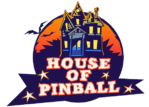If you’ve ever walked up to a pinball machine for sale and seen a score in the millions, you might have asked yourself: Why so many zeros? Is it all just flash, or does the score tell you something deeper about the game?
At House of Pinball, we believe understanding the story behind pinball scoring can help you become not just a better player—but also a smarter buyer. This post will explore the hidden logic behind pinball scores, why they’ve skyrocketed over time, and how scoring influences the machines you should consider owning.
📜 A Brief History of Pinball Scores
In the early days of pinball—back in the 1930s and ’40s—machines were mechanical and scoring was simple. You might score 100 points total in an entire game.
As gameplay grew more complex and solid-state technology took over in the late 1970s, pinball manufacturers had to reimagine how scoring could reflect:
- Game length
- Player achievement
- Psychological reward
That’s when scores jumped from hundreds to thousands, and eventually into hundreds of millions.
💡 Why 1,000,000 Points?
The short answer? Psychology and design.
1. Big Numbers Feel More Rewarding
A bump from 10 to 20 points doesn’t feel as exciting as jumping from 980,000 to 1,000,000.
Manufacturers realized that inflated scoring systems created stronger emotional engagement. Players felt like they were accomplishing more—even if it was just a larger number.
🧠 Fun fact: This is similar to arcade games or mobile apps using coins or gems—it’s gamified psychology at work.
2. Room for Bonus Multipliers
By expanding the scale of points, game designers could include:
- Bonus multipliers
- Combos
- Mode-based scoring
If your machine maxed out at 100 points, a 3x bonus would feel meaningless. With millions, there’s more “math room” to create excitement.
3. Scoring Is a Narrative Tool
Scores tell a story about the machine and how it’s meant to be played.
- Machines like Addams Family (1992) use large scores to show progression through multiple modes.
- Modern Stern machines may award 500,000 points for a single shot—but only if it’s part of a combo or mission.
Understanding how a machine distributes points helps you understand what kind of player the game rewards.
📊 Score Inflation Over Time
Here’s a quick look at how scoring has evolved:
| Era | Average Top Score | Notes |
|---|---|---|
| 1950s EM Machines | 100–1,000 pts | Very basic scoring reels |
| 1970s Early SS Era | 10,000–100,000 pts | Early adoption of digital scoring |
| 1990s DMD Games | 10M–500M+ pts | Deep rulesets, bonuses, and multiball modes |
| 2020s LCD Era | Variable (Can exceed 1B pts) | Balanced against wizard modes and extended play |
📌 Important when buying: Some machines may feel “harder” not because of difficulty, but because of lower-scoring systems. A newer player may enjoy a game with inflated scoring, as it offers more frequent rewards.
🔎 What Scoring Tells You When Buying a Machine
When you’re evaluating a pinball machine for sale, understanding its scoring model can help you:
✅ Gauge the Type of Experience
- Low-scoring EMs offer simple, reflex-based gameplay.
- Mid-range SS games provide balance between strategy and reaction.
- High-scoring modern machines offer story-driven, mode-heavy gameplay.
✅ Understand Replay Value
- Games with more scoring opportunities tend to keep players engaged longer.
- Machines that only score in one way (e.g., hitting a single target) may feel repetitive.
✅ Spot Value in Price vs. Features
- A $5,000 machine with deep scoring modes (like Lord of the Rings) might offer better value than a $4,500 EM with limited scoring appeal.
🔧 Common Scoring Features to Look For
When shopping, here are a few scoring-related terms worth understanding:
| Feature | Meaning |
|---|---|
| Jackpot | High-value scoring tied to specific objectives |
| Bonus Multiplier | Score boost based on end-of-ball performance |
| Combo Scoring | Points increase when making rapid consecutive shots |
| Wizard Mode | Final game stage with major scoring potential |
💬 Pro tip: Ask the seller if the machine has factory settings or if scoring has been customized. This can affect game balance.
🛒 Buying the Right Machine Based on Scoring
So how does all this help you pick the right pinball machine for sale?
1. Are You a Competitive Player?
Look for games with:
- Balanced scoring systems
- Limited exploit opportunities
- Deep but fair multipliers
Try:
✅ Iron Maiden, ✅ Deadpool, ✅ The Shadow
2. Are You a Casual or Family Player?
You may enjoy:
- Games with frequent jackpots
- Generous point inflation
- Lots of audio/visual feedback for scoring
Try:
✅ Attack From Mars, ✅ Elvira’s House of Horrors, ✅ Star Wars (Stern)
3. Do You Prefer Classic Gameplay?
You might enjoy:
- 1970s–80s games with simpler scoring
- No LCD screens or deep code
Try:
✅ Xenon, ✅ Eight Ball Deluxe, ✅ Firepower
🧠 Final Takeaway: Score Smart
Pinball scoring is more than just numbers—it’s a language of reward, skill, and design philosophy. Whether you’re chasing billions or cracking 100,000 for the first time, knowing how scoring works can guide your buying decision and enhance your appreciation of the game.
🎯 Ready to Buy a Machine That Scores Big?
At House of Pinball, we stock everything from classic EMs to modern LCD powerhouses—with machines hand-selected for condition, scoring integrity, and player appeal.

